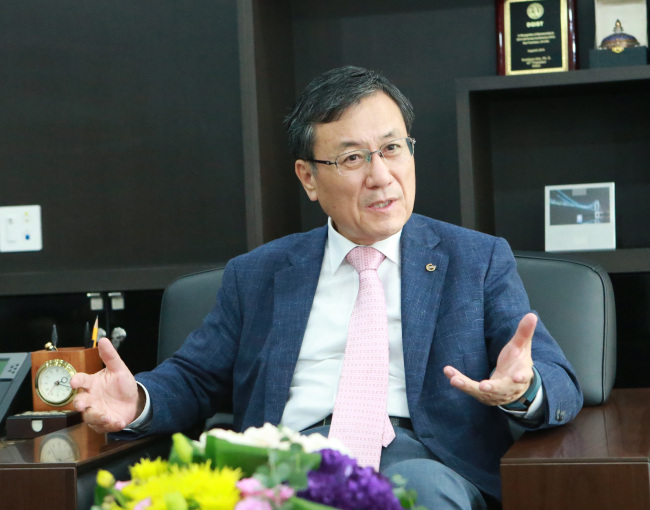In 2004, a handful of people gathered at a small building in Daegu to watch the launch of a tiny state-run research institute. Ten years on, the Daegu Gyeongbuk Institute of Science and Technology has blossomed into a research-oriented university, utilizing research and education to boost Korea’s economic growth.
“The objective of DGIST is to establish itself as a world-leading research university,” said Shin Sung-chul, the first president of DGIST. “For this purpose, we aim to foster talented individuals capable of creative thinking. They will play a pivotal role in the technological advance of Korea.”
DGIST opened its graduate program in 2011 and undergraduate program in March 2014. It now claims to be the only university in Korea that has both an education division ― graduate and undergraduate schools ― and research institutes. Because of this characteristic, the school is able to use its accomplishments to develop applicable technology, officials said.
DGIST focuses on encouraging its students to engage in what it calls “convergence studying,” conducting studies across various fields.
Convergence, which has risen to prominence in recent years, involves bringing together previously unrelated fields ― such as life science and computer engineering ― to create new fields of study such as bioengineering.
Among the various possibilities, medicine can join with information technology to make use of its user-friendly traits. One of the hot-button issues in Korea, “telemedicine,” which provides remote medical treatment to patients, is a prime example of the convergence taking place in the country.
It is also in keeping with President Park Geun-hye’s creative economy initiative, which calls for boosting the economy by turning creative ideas into business opportunities through science and technology. The incentives for outside-the-box thinking appear to be higher than ever.
Shin expressed hopes that DGIST will provide support for creative thinking through its unique educational system.
While the university does not boast a parade of acclaimed alumni due to its short history (10 years as an institution and 3 1/2 years as a university), Shin said that this allows it to attempt innovative education programs.
The undergraduate school at DGIST does not consist of departments. Instead it is comprised of a single school of basic science that allows students to explore all fields of learning, not only in science and engineering but also in social sciences and the humanities, the school said.
The faculty members of the undergraduate school not only teach classes, but also serve as mentors for undergraduates in an effort to provide help for budding scholars. The undergraduate school also uses electronic textbooks developed by faculty members at DGIST.
Its primary educational philosophy is “convergence, leadership and entrepreneurship,” a direct reference to DGIST’s goal of fostering leaders whose thought process are not limited by preconceptions.
The graduate school is also unorthodox, compared to traditional academia. Although it has departments, they are not named after traditional fields like biology, chemistry or physics. Instead, its departments are emerging materials science, information and communication engineering, robotics engineering, energy systems engineering, brain science and new biology.
According to the school, each department encourages students to expand their research beyond the boundaries of existing fields of study and to explore all possibilities to solve the problem at hand.
For example, a student of robotics engineering ― which deals to a large extent with medical robots ― would not just work on designing robots. He or she would also be motivated to conduct research involving life science and biology as well as traditional robot engineering.
“As of now, DGIST has to benchmark universities with world-renowned research. But if our innovative undergraduate programs succeed, they will have to benchmark us,” he said.
The university does not only focus on academics; to stay true to its founding purposes, it is actively working to host large-scale research facilities.
DGIST is aiming to lead the research in cyberphysical systems, which is the conjoining of and coordination between computational and physical entities.
In order to do so, it recently opened the CPS Global Center to jointly conduct studies with prestigious higher education institutes around the world. The CPS research consortium consists of scholars from the University of Michigan, University of Virginia, Carnegie Mellon University and University of Pennsylvania
In 2012, it signed an agreement with the top-tier research institute Lawrence Berkeley National Laboratory in the U.S. and founded the DGIST-LBNL Joint Research Center.
DGIST is also running research centers on brain research, health improvement via technology and other fusion studies.
But the university still has long way to go before it joins the ranks of the top science and technology research institutes. While governmental support has provided infrastructure for the school, it still lacks funding and manpower.
Shin said that DGIST still need more qualified faculty members, researchers and administrative staff, as well as funds to operate. He said that local governments should offer help, as the school was a “great gift (bestowed) by the central government.”
The students of DGIST are not only involved in studying and research, Shin added. He said the educational goal of the institute was to nurture global leaders with the three “C”s ― creativity, contribution and care ― since it is important for individuals to be able to help and care for others as well as think creatively.
“As the students at DGIST are being supported by the country, they must be mindful of how they can contribute to the betterment of Korea and the world,” he said.
By Kim Sang-il and Yoon Min-sik
(
smile56789@heraldcorp.com) (
minsikyoon@heraldcorp.com)








